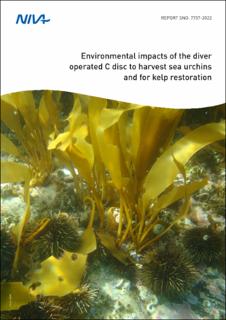| dc.contributor.author | Michelsen, Helena Kling | |
| dc.contributor.author | Fagerli, Camilla With | |
| dc.contributor.author | Christie, Hartvig C | |
| dc.date.accessioned | 2022-04-21T07:58:34Z | |
| dc.date.available | 2022-04-21T07:58:34Z | |
| dc.date.created | 2022-04-20T16:55:12Z | |
| dc.date.issued | 2022 | |
| dc.identifier.isbn | 978-82-577-7473-8 | |
| dc.identifier.issn | 1894-7948 | |
| dc.identifier.uri | https://hdl.handle.net/11250/2991823 | |
| dc.description | Project Manager Helena Kling Michelsen | en_US |
| dc.description.abstract | NIVA did a 2-day environmental evaluation of the diver operated suction device “C disc” constructed by C robotics. Because the C disc uses suction from a water pump to suck sea urchins from the seafloor, it will collect bycatch and may have some harmful effects on the seafloor. It can also be used for kelp restoration in northern-Norway. This survey tested the C disc at two sea urchin barren grounds around Tromsø (Ytre Kårvika, Kvalsundet and Berg, Balsfjord) in May 2021. Analysis of catch efficiency on target sea urchins, bycatch and effects on the sea floor using video transects and frame counts was done at both sites. About 81 – 89 % of the catch consisted of the target species sea urchins and the CPUE was on average 78 ind./min (61 – 96 ind./min). Of these 11 % were damaged by the C disc. Bycatch accounted for 11 and 19 % of the catch and reflected the local community consisting of mainly larger loose sitting organisms. There was little to no damage observed on bycatch organisms, except for barnacle and blue mussels. There was a reduction in loosely fastened organisms after using the C disc, and the most impacted organisms reflected the bycatch. If the bycatch is kept in sea water and returned to sea soon after capture, they are likely to survive. The survey is only representative for hardbottom sea urchin barrens in northern-Norway. | en_US |
| dc.language.iso | eng | en_US |
| dc.publisher | Norsk institutt for vannforskning | en_US |
| dc.relation.ispartof | NIVA-rapport | |
| dc.relation.ispartofseries | NIVA-rapport;7737-2022 | |
| dc.subject | Undervannsstøvsuger | en_US |
| dc.subject | Suction device | en_US |
| dc.subject | Restaurering | en_US |
| dc.subject | Restoration | en_US |
| dc.subject | Miljøundersøkelse | en_US |
| dc.subject | Environmental survey | en_US |
| dc.subject | Kråkeboller | en_US |
| dc.subject | Sea urchins | en_US |
| dc.title | Environmental impacts of the diver operated C disc to harvest sea urchins and for kelp restoration | en_US |
| dc.title.alternative | Environmental impacts of the diver operated C disc to harvest sea urchins and for kelp restoration | en_US |
| dc.type | Research report | en_US |
| dc.description.version | publishedVersion | en_US |
| dc.rights.holder | © Norsk institutt for vannforskning/Norwegian Institute for Water Research. The publication can be cited freely if the source is stated. | en_US |
| dc.subject.nsi | VDP::Matematikk og naturvitenskap: 400 | en_US |
| dc.subject.nsi | VDP::Mathematics and natural scienses: 400 | en_US |
| dc.source.pagenumber | 23 | en_US |
| dc.source.issue | 7737-2022 | en_US |
| dc.identifier.cristin | 2017975 | |
| cristin.ispublished | true | |
| cristin.fulltext | original | |
